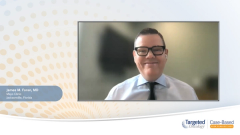
Treatment Sequencing for BPDCN: Expert Insights and Strategies
Expert perspectives on the sequencing of treatment options for blastic plasmacytoid dendritic cell neoplasm, considering patient age, response to tagraxofusp, venetoclax-based therapies, clinical trials, and future possibilities for targeted agents.
Episodes in this series

Transcript:
James M. Foran, MD: I think an important question is how do we sequence treatment for patients with BPDCN [blastic plasmacytoid dendritic cell neoplasm]? I’ll start by saying that this case, this 87-year-old man, is emblematic of the fact that we’ve moved on from the nihilism of 10 and 20 years ago for patients who were 75 or 85 years old. We now have therapies for acute leukemia, and in this case, BPDCN, that are manageable, that are proportional, that have enough benefits to make it worth the toxicity and where we can navigate the toxicities.
So it’s important that we do offer patients treatment. Our standard first-line treatment for a patient with BPDCN in our cancer center is to initiate therapy with tagraxofusp. That is our first-line treatment. We’ve had many patients come to us who were diagnosed with acute leukemia, [whose clinicians] may or may not have appreciated it was a BPDCN. They’ve started therapy typically with hyper-CVAD [hyperfractionated cyclophosphamide, vincristine, doxorubicin (Adriamycin), and dexamethasone]. You can get high remission rates or relatively high remission rates with hyper-CVAD…. That can be an effective strategy. It doesn’t seem to be as durable a response, and if you’re doing that for a patient, it’s really with the intent of consolidating with an allogeneic transplant.
When I’m thinking of our treatment sequencing, we’re typically trying to make the diagnosis, then initiate a patient on therapy with tagraxofusp whenever possible. Occasionally we’ve had clinical trials; we would certainly screen for a clinical trial. We will initiate HLA [human leukocyte antigen] typing and evaluate that patient to see whether they’re an appropriate candidate for an allogeneic transplant, almost certainly not for an 87-year-old [patient], but for a 72-year-old [patient], maybe a 77-year-old [patient]; certainly younger adults. You’d evaluate to consolidate that remission with an allogeneic transplant.
Now what if they don’t remit? What if they get tagraxofusp and they’re in that minority, that small minority that doesn’t go to remission, or they relapse before you’re able to get them to an allogeneic transplant? Then we would move to a second-line therapy typically with venetoclax-based treatment. There are case reports, anecdotes, and small series showing the benefits of venetoclax and some responses to a venetoclax-using combination in BPDCN. My colleague, Naseema Gangat, [MBBS], from Mayo Clinic in Rochester, [Minnesota], published our series using venetoclax-based therapy in BPDCN that we contributed to. It showed that with HMA [hypomethylating agent]-based therapy and venetoclax, you can get remission. So that’s reasonable as a second-line agent. In a younger patient, we would typically go to a more intensive treatment like hyper-CVAD.
There are studies looking at adding venetoclax to hyper-CVAD. I will tell you, that’s a trial question. It’s possible to do it. I’d be a little cautious about doing that outside of a clinical trial because there is added toxicity when venetoclax is added to intensive chemotherapy, but to salvage a relapse, to get a second remission, we would do that, particularly if that’s a patient we’re trying to get to transplant. Otherwise, we advise a lower-intensity, venetoclax-based regimen.
And we’d move to allogeneic transplant. We and others, some of the large volume centers, have looked and are looking at other CD123-targeted approaches for BPDCN even after the failure of tagraxofusp. There are other antibody-based or CAR [chimeric antigen receptor] T-cell therapy–based or even bispecific-based targets trying to exploit that, looking to see if we can get meaningful remissions for patients with acceptable toxicity. And so, in the second line, if tagraxofusp doesn’t work, we’d move to intensive chemotherapy for younger patients with or without venetoclax; that really should be done in a trial. Or [we’d consider] a HMA-venetoclax combination in older patients, again, with the intent of inducing remission to support allogeneic transplant.
We strongly advocate for patients with BPDCN to be eligible for clinical trials. Based on their mutation profile, you might find that there’s a mutation profile amenable to a targeted agent, particularly as that field becomes more robust. The mutations in BPDCN are not easily targetable—I mentioned that alread —but that’s an evolving field and I’m hopeful that in future we’ll have targeted agents for some of the mutations that you might see in BPDCN as well.
Transcript is AI-generated and edited for readability.










































